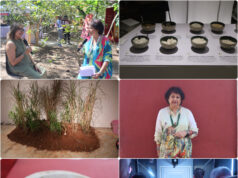Goa’s seafood restaurants need to use their primary resource, fish, sustainably and preserve the local ecosystem to prevent fish famine off the coastline, a phenomenon caused by overfishing, according to chef Abhishek Deshmane, who conducted a workshop ‘Reimagined Coastal Food’ on the second day of the ongoing Serendipity Arts Festival (SAF) 2023.
Deshmane, an executive chef at the popular Slow Tide Restaurant, specialising in seafood in Anjuna, also spoke about the importance of utilising local and seasonal ingredients respectfully, as showcased through two dishes – Red Snapper Ceviche and Sasam Salad.
“Restaurateurs and stakeholders in the food and beverage industry should pay attention to local customs and traditions surrounding food and follow the local (sustainability) calendar. There is one particular calendar called ‘Know Your Fish: Seafood Recommendations’ that is a sustainable ocean-sensitive seafood calendar for the west coast of India,” said Deshmane, who was a key facilitator at the workshop, which was a part of the Festival’s culinary segment curated by Chef Thomas Zacharias and The Locavore Team.
Deshmane stated that the fish breeding season coincides with the auspicious month of Shravan during the Goan monsoon season. As the consumption of non-vegetarian items is not recommended during this period, there is a shift within the restaurant industry to local vegetables and grains to accommodate religious sensibilities. Those who do not observe Shravan can opt for pickled or preserved fish, such as balchão (a pickling method introduced by the Portuguese during their colonial rule) and para (a Goan spiced and pickled dried fish recipe), he said.
“During the monsoons, vegetarian delicacies like yam and colocasia leaves (patrodo in Konkani) are widely available, which can substitute fish in the menu till the fishing ban during the breeding season ends,” said Deshmane.
The fishing industry in Goa is booming, with the coastal state’s seafood exports for the current financial year crossing Rs. 1,500 crore. With the demand increasing exponentially in recent times,
Siddharth Savkur, CEO of the Kamaxi Group, which runs the country’s only culinary B-school, also emphasised that everyone in the restaurant and food and beverage industries should be educated about the importance of observing the fishing ban.
“Restaurants could use this period to showcase other meats and seasonal monsoon produce. They could also patronise small, traditional fishermen during this period. Though their haul is smaller, they offer varieties of small fish that are known to locals but go unnoticed by tourists,” said Savkur.
When it comes to sustainable fishing practices, Deshmane stated that while fishing farms would enable controlled breeding of red snapper or other fish, “strict regulations have to be implemented to ensure that fish are bred ethically and malpractices like chemical enhancement are eliminated.”
Deshmane also drew parallels between Goa and Peru, due to a shared Iberian colonial heritage and spotlighted the association through the Red Snapper Ceviche dish that Deshmane prepared during the workshop.
“Peru and Goa share several similarities – both are former colonies, Spanish and Portuguese, respectively; they have good coastlines, similar climates and similar spicing practices due to the proximity of Spain and Portugal and the trade routes established during the Age of Discovery in the 15th century,” said Deshmane.
Deshmane’s Sasam Salad highlighted the importance of eating seasonal produce due to its health benefits and cooling properties, which are now vital due to the changing climate. He also used cashews in the fish to promote the essence of Goa.
The health benefits of consuming local seasonal produce were further underscored by Amey Naik, secretary of the National Restaurants Association of India – Goa Chapter.
“In-season produce is fresher, harvested at the right time and naturally ripened, due to which it has more flavours and nutrients. It also supports our body’s natural nutritional needs as per the season and geographical location, ensuring we eat the best that the season offers. It also supports local farming,” stated Naik.






